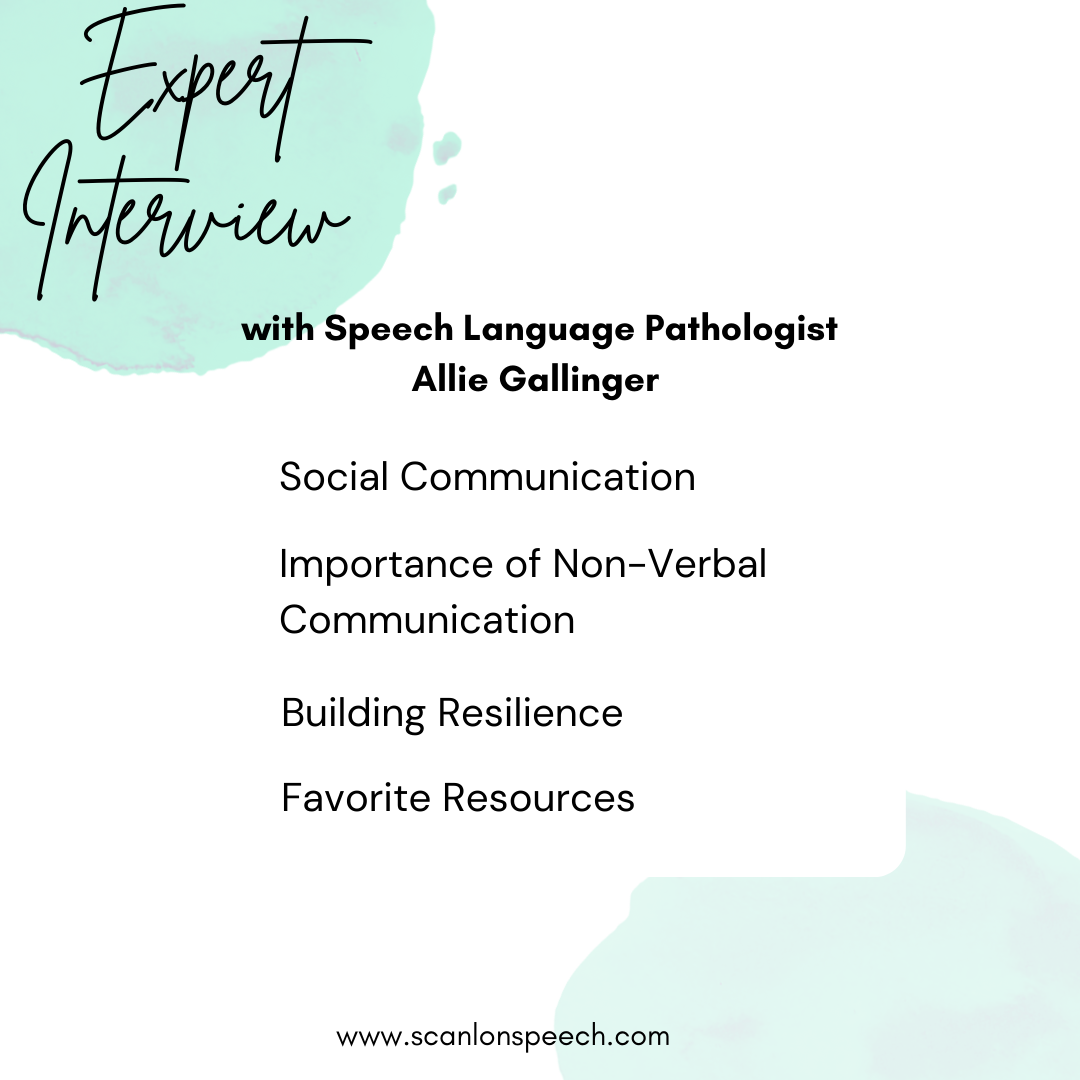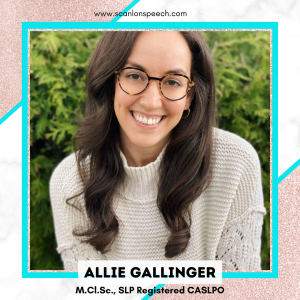Sign Up For Our E-Blast To Receive Information on our Books, Speech Therapy materials and our latest freebies!
Social Communication and Speech Therapy: Interview With Allie Gallinger

Welcome to another installment of Interviews with Experts. In these interviews, I ask 5 questions to experts in various professions related to speech language pathology and early childhood development. It’s hard to believe that it’s been more than 6 years since my last interview!
I’m so happy to welcome Allie Gallinger, M.Cl.Sc., SLP Registered CASLPO.

Allie is a registered speech-language pathologist with the College of Audiologists and Speech Language Pathologists of Ontario (CASLPO). She is also a member of the Ontario Association of Speech Language Pathology and Audiology (OSLA).
Allie received her Master of Clinical Science, M.CI.Sc. from the School of Communication Sciences and Disorders at Western University. Through her schooling, she became passionate about working with children, adolescents and teens with speech and language disorders.
In private practice settings, Allie has worked with infants, children, adolescents and teen with speech and language disorders. Allie has worked with children with varying speech and language needs such as: social communication difficulties, stuttering, articulation disorders, motor speech disorders, late talkers, and expressive and receptive delays. She tailors each session to the child’s needs and age to ensure that therapy is fun and motivating. Allie includes caregivers and other family members in every aspect of assessment and treatment to ensure that her clients are working on goals in their homes to achieve the greatest gains in therapy. Allie provides homework that is fun and motivating and ensures that families know how to practice at home with their children.
Allie will answer questions about the importance of understanding and appropriately addressing the social and emotional needs of young children during speech therapy.
The first question is usually personal and related to how the interviewee became interested in working in a particular area or with a special population. For the last question, I ask for recommended resources.
*Amazon affiliate links have been included for your convenience. Any earned commissions help maintain the costs of this website.
Question 1:
According to your extensive biography you have experience working with many different speech and language disorders and varying age groups. One speech and language need that you enjoy treating appears to be social communication difficulties. Can you explain how you became interested in treating this area?
At one of my previous jobs, I worked for a private practice. Many of the clientele at this practice were children that had various needs such as executive functioning difficulties and autism spectrum disorder. As a result, I frequently worked closely with occupational therapists who did a lot of work around self-regulation. We realized that very frequently, children with self-regulation difficulties often had social communication difficulties. After this realization, I changed my focus to this area and spent a lot of time building my practice around social communication skills. I have found this area of our field to be exceptionally rewarding. It is a very special feeling when a parent tells me that their child comes home from school raving about how much fun they had at recess or when my client tells me about a new friend. These skills come naturally to many people but sometimes children just need a little bit of instruction to make implicit social norms more explicit.
Question 2:
In your blog post, Videos for Non-Verbal Communication, you share some of your favorite silent animation videos on Youtube. Several years ago, I attended a workshop by Dr. Anna Vagin, PhD, author of YouCue Feelings Using Online Videos for Social Learning, who also highly recommends using online videos “to accelerate learning about feelings and relationships”. Why is non-verbal communication so important to social interaction?
Non-verbal communication (facial expression, body language and tone of voice) and the direct teaching of these skills is a huge part of my practice. Non-verbal communication is just as important as the words we say. For example, if a child gets into an argument with their friend and says, “Sorry” but is rolling their eyes (facial expression), slouching down (body language) and their voice is low and loud (tone of voice), the non-verbal cues are going to hold more weight than the apology they are offering. Many children with social communication difficulties miss out on non-verbal communication cues. As a result, they often misinterpret the message others send and/or don’t realize how they are being perceived by others. I wrote a children’s book on this topic titled David and Delilah Discover: It’s More Than What We Say. It is a three-part story that covers facial expression, body language and tone of voice and it will be released hopefully in the winter so everyone can stay tuned for that!
Question 3:
I’ve read a few articles suggesting that the coronavirus pandemic has effected how we communicate as many of us had to isolate, quarantine, learn on-line, communicate digitally, wear masks, and socially distance. This was and has been a novel experience for many and these effects and mitigation strategies continue in many areas. Reading and interpreting subtle facial cues and other non-verbal forms of communication is a challenge for some children/students on our caseloads. As speech language pathologists, what can we do to ensure our students are still able to understand and interpret non-verbal forms of communication during this ongoing pandemic?
The COVID-19 pandemic has impacted the social skills of everyone. Here in Toronto, Canada, I have been so pleased to see how happy all my clients have been since the return to school. I am so thankful that many of them are thrilled to be around same age peers and socializing without too many challenges and setbacks. However, I do agree that mask use can be very challenging for subtle non-verbal communication cues. My biggest tip is to help children focus on what they can see and hear, which is tone of voice, eyes/eyebrows, and body language. While the mouth does offer a multitude of information about what someone is thinking and feeling, we can glean a lot of information from the above non-verbal cues. I would implore speech-language pathologists and other educators working on social communication skills to focus specifically on these aspects of non-verbal communication to help set their clients up for success.
Question 4:
Resilience has been an extremely popular word to hear during this pandemic. However, as speech language pathologists we realize that resilience is a pillar of speech therapy, especially for adolescents with communication disorders. According to an ASHA journal article titled, Motivation, Rapport, and Resilience: Three Pillars of Adolescent Therapy to Shift the Focus to Adulthood, “resilience is a learned skill that can be taught”). Social support and fostering positive social relationships is one way to increase resiliency. What are some ways we can help children who have social communication challenges be more resilient?
The number one way to help children who have social communication challenges be more resilient is by equipping them with many important skills through direct teaching, books, videos, and role play. I never want my clients to feel that they must mask themselves to fit in, but I do want to give them the tools to have positive social interactions with their peers. For some children, this is explicitly teaching them how they can join a group or ask someone to play. For other children, this might be helping them to learn how to be a flexible thinker or how to be okay with losing a game and/or not bragging when they win a game. It really does depend on the need of the child, but overall, the most important aspect of my practice is to help build my clients’ confidence, especially when it comes to social interactions.
Question 5:
Can you recommend some of your favorite resources (books, websites, others) to help readers learn more about social/emotional development and how to foster them?
As I mentioned in question 2, my children’s book on non-verbal communication skills will be coming out soon. Some other resources, especially for SLPs that I use every day are resources from the Social Thinking Curriculum such as We Thinkers and Superflex. Another website that I use very often (at a cost) is Everyday Speech. It includes a multitude of teaching videos, handouts, and games on the topics of social communication and self-regulation. Other books, videos and therapy materials that I love can be found in my blog posts here:
And, that’s a wrap!
Thank you, Allie, for taking the time to share your insight, knowledge, and favorite resources for social and emotional development!
Here are some more posts from my Interview with Experts Series:
Expert Interview: Autism and Sensory Needs
Expert Interview: Oral Motor Development and Pacifiers
Expert Interview: Executive Functions and Speech Therapy
Expert Interview: Bilingual Language Development
Expert Interview: Language & Picky Eating in Internationally Adopted Children
If you are an expert in speech, language, literacy, AAC, child development, etc. and would like to participate, please contact me at [email protected]
- Enhance Your Speech Therapy Sessions with ‘Picky Kitty’ – A Must-Have Game for Every Speech Therapist
- Same and Different: Why Speech Therapists and Educators Should Target this Basic Concept
- New Beginnings for Scanlon Speech Therapy
- Articulation Speech Therapy: Favorite Activities, Games, and Books to Target the TH Sounds
- Articulation Speech Therapy: Favorite Activities, Games and Books to Target the L Sound
